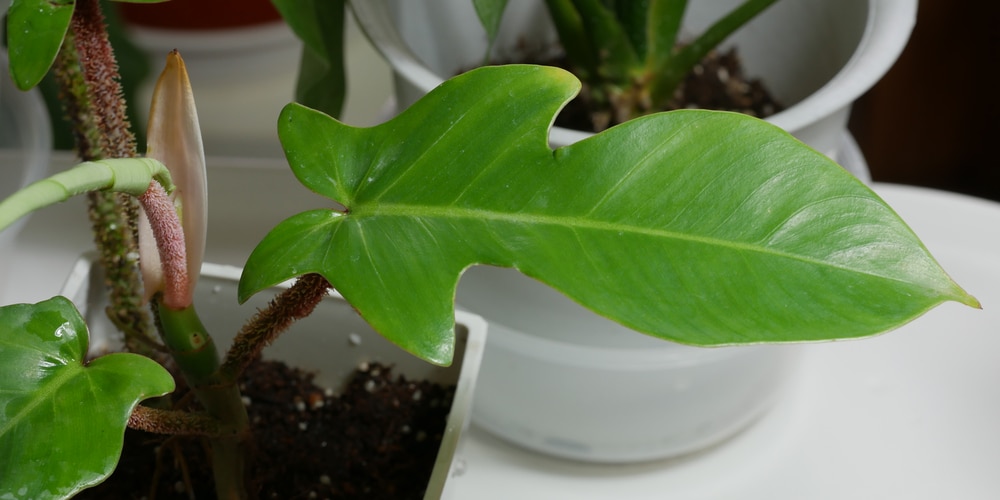The Philodendron Squamiferum is a beautiful, large plant that grows slowly. This large, leafy plant can grow up to 8 feet tall. It’s a climber with unique stems that are covered in red hairs. The leaves are green and have a waxy texture.
The flowers of the Philodendron squamiferum are white with an orange center. These plants need well-drained soil and indirect sunlight to thrive. This blog post will teach you how to care for your pet philodendron squamiferum.
What is a Philodendron Squamiferum

The Philodendron squamiferum is a member of the Araceae family and is native to tropical rain forest habitats in Central and South America. It’s commonly found in the Brazilian rainforests and French Guyana. This plant has distinctive green leaves that are the shape of oak leaves and hairy red stems. It’s become a very popular houseplant in recent years due to its unique appearance.
The Philodendron squamiferum is extremely toxic, so care should be taken when growing around pets or children. This plant contains calcium oxalate crystals, which are irritants to humans’ skin, mouth, tongue, and throat – who may experience symptoms similar to an allergic reaction. Eating any part of this plant will cause the most severe symptoms, including numbness, swelling of the tongue, breathing difficulties, and stomach pains accompanied by vomiting.
How to care for a philodendron squamiferum

The Philodendron squamiferum is relatively easy to care for as long as you get the basics of sunlight, water, soil, and humidity right. Here are some tips to help you grow a healthy and thriving plant indoors or outside.
Sunlight Needs
Place the philodendron squamiferum in bright indirect sunlight near a window. In summer, it can be placed outside on a shady patio or decking. If you live in USDA zones 9 to 12, you can plant your philodendron outside in a flower bed. Don’t leave your plant outside in the winter if you live in an area that gets frost. Make sure to keep your plant out of direct sunlight as it can damage its leaves.
Watering Requirements
These plants do need to be watered regularly, but too much water will cause root rot. Be aware that they are not drought-tolerant plants and should not be left dry for long periods of time. Leaves will start turning yellow if you underwater your plant for too long.
Temperature
The recommended temperature for your plant is between 60°F to 78°F. Avoid placing your plant in draughts from an open door or window or near the air conditioning. Don’t leave your plant outside if frost is expected. Also, avoid placing your plant too close to radiators or fireplaces that may dry them out.
Soil
Use a good quality potting soil mixed with some sand or perlite. Soil should be loose and well-draining. Aim to create a ground with a pH range of between 5.5 – 6.5. As the philodendron squamiferum is a climbing variety, you can add a moss pole to the pot for support. Alternatively, grow your plant against a fence outdoors, and it will get quite large.
Humidity
High humidity levels are needed for this plant as they originate from tropical locations. Aim to create an environment with a humidity of at least 50% by misting your plant’s leaves, using a water and pebble tray, or investing in a humidifier. Good humidity levels will help increase the plant’s lifespan.
Fertilizer
Feed once every two weeks with a diluted liquid fertilizer, taking care not to damage the roots or leaves while applying it. Use liquid fertilizer at half strength during the spring and summer months when the soil becomes dry enough to allow fertilizers through its roots.
Pests
Philodendrons are pretty pest resistant but can be affected by sap-sucking insects such as spider mites and mealybugs. These can be treated with commercially bought
insecticidal soap or neem oil. It’s a good idea to regularly check your plants for pests, particularly after bringing a new plant into your home.
Conclusion
Philodendron squamiferum should be positioned in bright indirect light and watered regularly; good humidity levels will help increase its lifespan. Apply water directly onto soil with hands taking care not to damage the foliage. Do not over-water the plant as this can lead to root rot.
Related: Philodendron Erubescens